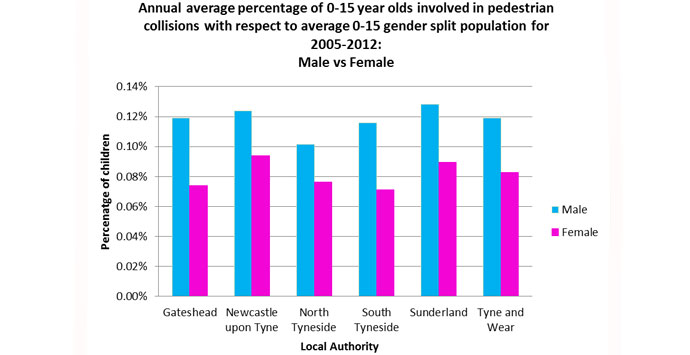#Safetyforlife: Using the relationship between gender and child pedestrian incidents to reduce fatalities
AECOM’s Lindsey McConnell was recently selected as a regional finalist at the Society of Road Safety Auditors’ Colas competition for her paper on child pedestrian casualties in the U.K.
Child pedestrian casualties remain the second-leading cause of unintentional injury-related death among 5 to 14 year olds in Great Britain. More than 69 percent of all children killed on its roads are pedestrians. Yet, this area is lagging behind in casualty reduction.
This is why I am extremely passionate about my research investigating the factors that result in increased casualty risk associated with male children. I firmly believe that increasing the knowledge behind the causes for child pedestrian casualties will help to implement new safety guidance to reduce child deaths on our roads, which is vital to helping to reduce overall accident statistics.
During my final year of university, I researched the relationship between gender and pedestrian casualty rates of children ages 0 to 15. Previous studies implicated gender as a potential risk factor, suggesting that male children were at an increased risk of injury. However, no research was found specifically relating to gender and its impact on child pedestrian casualties.

Percentage of children injured in pedestrian-vehicle collisions within six local authorities of the U.K.
The methodology used logistic regression modelling, producing statistically significant evidence suggesting that younger casualties were more likely to be male. Further findings suggest that males are more at risk when crossing away from pedestrian crossings, as well as crossing while masked by a parked vehicle. In regards to vehicle manoeuvre, this study found that males have an increased risk when a car is slowing, stopped or waiting.
 Flowchart depicting the research methodology used in the study.
Flowchart depicting the research methodology used in the study.
The reasoning behind this is complex and, ultimately, the findings are a result of behaviour, intellectual and cognitive development, risk taking and hazard perception differences in males and females. Thus, males make different, more-hazardous road safety decisions and ultimately, this increases male casualty numbers.
While it is not possible to design infrastructure for males and females separately, I do believe that we can use my research to help alter our approach to education. I believe that males and females should be educated in different ways in order to target specific risk factors associated with each gender, thus helping to improve all casualty rates.
Since carrying out this study, I have presented my findings to a number of target audiences, including the Society of Road Safety Auditors. I am hopeful that through further investigation, this study will help civil engineers design safer road networks for use by the younger generation.
I believe that civil engineers have a duty to ensure that every design is as safe as possible for all users. In order to do this, we must continue to adapt and learn from vital research being done on this subject. If each of us makes it our duty to learn from the data, then I am positive we will create a safer environment for everyone.
 Lindsey McConnell is a civil engineering graduate working in AECOM’s highways sector. After falling in love with Newcastle in England while visiting her sister, Lindsey left Northern Island and moved to the city to study. She graduated in July 2014 with a first-class master’s degree from Newcastle University and is currently working on publishing her first paper on this topic.
Lindsey McConnell is a civil engineering graduate working in AECOM’s highways sector. After falling in love with Newcastle in England while visiting her sister, Lindsey left Northern Island and moved to the city to study. She graduated in July 2014 with a first-class master’s degree from Newcastle University and is currently working on publishing her first paper on this topic.
LinkedIn: Lindsey McConnell







